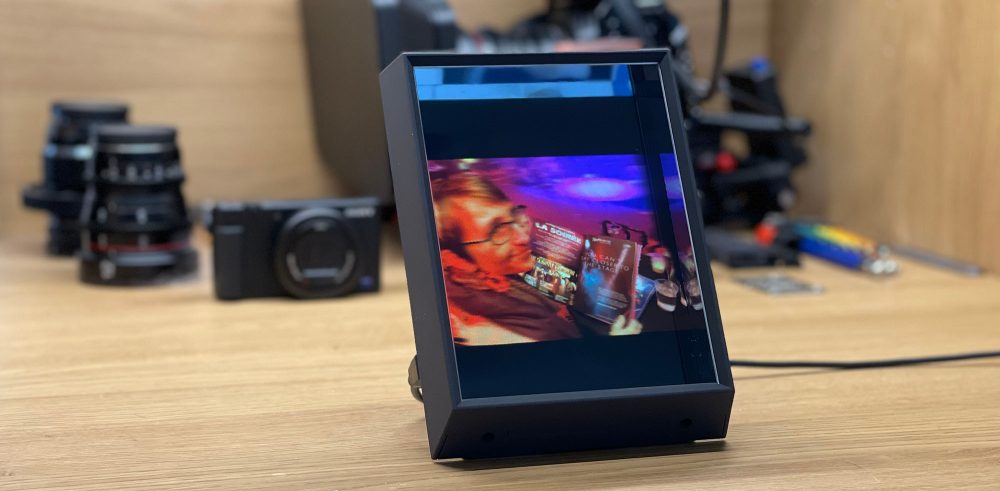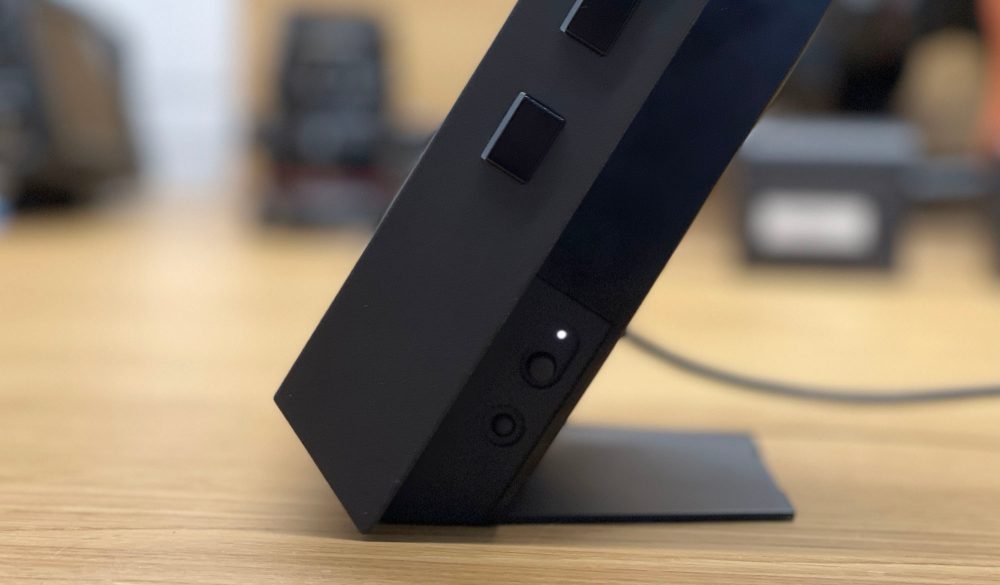
We tend to be wary about crowdfunding campaigns, as not all deliver, but the Looking Glass Portrait was too interesting to pass up as a way to turn iPhone Portrait mode photos into three-dimensional holograms.
It won’t be available until (at the latest estimate) October, but I got a chance to try a pre-production model which I’m told is very close to the final version, and there’s a mix of good and bad news.
Science fiction versus reality
In science fiction, a hologram is a fully three-dimensional representation of a person or object that allows you to walk all around it.
Sadly, present-day reality falls a very long way short of that. The best we have so far are low-resolution images we can view from a limited number of angles. The Looking Glass photo frame very much falls into the latter category.
The company describes it as the first “personal holographic display,” and I think that description is fair enough. It’s certainly the first affordable consumer device I’ve seen that can display anything which meets today’s definition of the term.
You do, though, need to manage your expectations, as we shall see.
Look and feel
When switched off, the Looking Glass Portrait doesn’t look dissimilar to any other desktop digital photo frame. It’s a glass display in a black plastic housing. The screen measures 6.1 inches high by 4.5 inches wide, and the external dimensions are 7.2×5.3×4.1 inches.
That latter dimension – the depth – includes the stand, but the unit itself is pretty chunky, and that’s really the only clue that this is something out of the ordinary.
One key limitation
One key limitation worth mentioning right away is that the device doesn’t support HEIC images, only JPG ones. That’s important because it won’t be able to display any of your existing Portrait mode photos if you have your iPhone set to use HEIC – and you can’t convert them to JPG without losing depth data, rendering them useless for Looking Glass purposes.
That meant that, for me, I couldn’t use most of my existing portrait photos, which was a real shame.
You need to set your iPhone photo format to JPG (‘Most Compatible’) in Settings > Camera and then shoot Portrait mode photos.

AI conversion of 2D photos
You do, however, have one alternative, which I found works surprisingly well: purchase credits to have an AI convert 2D photos into pseudo-3D ones that can then be turned into holograms.
Interestingly, I couldn’t really see much difference between actual Portrait mode photos taken with my iPhone 12 Pro Max and AI-converted ones.
Credits cost $20 for 100 (20 cents each) or $150 for 1,000 (15 cents each). I’d imagine most people would be happy with 100 photos, so just budget an extra $20 on top of the purchase price.
Creating holograms
With the iPhone Camera app set to Most Compatible, shoot Portrait mode photos. AirDrop them to your Mac, then connect the device to your Mac.
You do this with two cables. The supplied USB-C to USB-C one, and a USB-C to mini-HDMI cable you’ll need to supply yourself. It will configure itself as an external display, with the usual hassles that involves (your main display often setting itself to low-res too), but that’s just a one-off process.
To transfer photos to the frame, you first import them into the HoloPlay Studio app. The app is pretty terrible! You can only import one image at a time, the user interface is basic and unintuitive, and it freezes a lot. Hopefully, this is something the company will address before launch.
Once you have your images imported into the app, they will immediately display on the frame while it’s connected – but disappear once you disconnect it. To actually transfer them, you need to press the Sync button once the photos have finished importing. You can see progress on the frame itself, and a message in the app tells you once it’s complete (or crashes, and then you just have to wait ten minutes before risking disconnecting the frame!).
Quality
I said in the intro that present-day holograms are low-resolution, and that’s true of the Looking Glass Portrait. Although the input resolution is 2048×1536 pixels, which isn’t too bad, the effective display resolution is very much lower.
Results are very variable, depending on the photo. I would say that the subjective effect is like viewing anything from a 240p to 480p video. A few holograms look impressive, but others just look incredibly fuzzy – with the latter sadly a lot more common than the former.
This short video below gives a good sense of what the images are like – though there is the challenge of trying to show a 3D display in a 2D medium! I move the camera from side-to-side to show the effect as best I can, including a few images where I show how the image breaks up if you move your head too far.
Note that the frame is oriented for portrait photos, while I almost invariably take landscape ones. The final shot of the original iPhone shows the full scale of the frame display used.
As with the quality of the images themselves, the 3D effect is also very variable. Some images really do have a sense of depth to them, while others … don’t. Either way, you’re limited in your ability to move your head from side to side while viewing the images.
As it happens, the best result I got was with a photo of Charlie, a cat who is sadly no longer with us (top photo). The photo has a lot of sentimental value for that reason, and it’s definitely a touching thing to see it brought to life in this way. This, ultimately, may be what drives the value of the product. If it can really animate a photo that has particular meaning to you, then that may itself justify the purchase price.
Holographic video
The frame can also display 3D video, though this requires a separate iPhone app called Record3D. This really needs the LIDAR scanner on the iPhone 12 Pro, though you can also use the front-facing camera on any iPhone with Face ID.
The app is a freemium one, and you’ll need to purchase both Full Access and export modules to use it with Looking Glass, which in the UK cost a total of £8 ($11).
Honestly, I’d have to say the video feature is a gimmick right now. With photos, the quality level is variable, but when it’s decent, it’s decent. With a video, the quality ranges from ok to terrible within a few seconds of playback. I tried it twice and have no plans to do so again.
Developer tool
Looking Glass can also be used as a developer tool, thanks to Unity and Unreal plugins. You can also output from 3D modelling tools like Blender. Those uses are beyond the scope of this review.

Looking Glass Portrait: Pricing and conclusions
The Looking Glass Portrait will retail for $349 and is currently available for pre-order at $299.
Generally, writing review conclusions is a straightforward process. I know which products to compare it to, and I have a good sense of the type of person who’ll want to own it, and consider it worth the money.
That isn’t the case here. This is a first-generation product in a new product category. There aren’t any alternatives out there that I have seen, nor are there likely to be any significantly better versions anytime soon. At some point, we’ll have something closer to the sci-fi dream, but that’s probably many years away yet.
So I think what I’d say is this. Looking Glass isn’t a consumer-ready product. It’s a product that offers techies a very early opportunity to play with an exciting new technology, as well as offering a tool for developers.
Though, interestingly, I ran it past a few friends, and non-techies seem most impressed with it! Perhaps because they haven’t grown up with the SF dream, so just compare it to a standard photo frame. However, I think they definitely wouldn’t want to do battle with the app and the trial-and-error nature of it.
You’ll need to be willing to experiment with lots of Portrait mode photos and find out which ones work and which ones don’t. You’ll need to be able to tolerate the frankly terrible Mac app. You’ll need to accept the huge gap between the dream and reality.
In short, the question you need to ask yourself is: Do holograms appeal enough to invest three hundred bucks in a chance to play with some bleeding-edge tech, which will often be disappointing and frustrating, but every now and then will delight you? And maybe, just maybe, that occasional delightful result will be a photo that has sentimental value for you.
Looking Glass Portrait is available for pre-order at $299, with shipping currently estimated for October.
Author: Ben Lovejoy
Source: 9TO5Google



